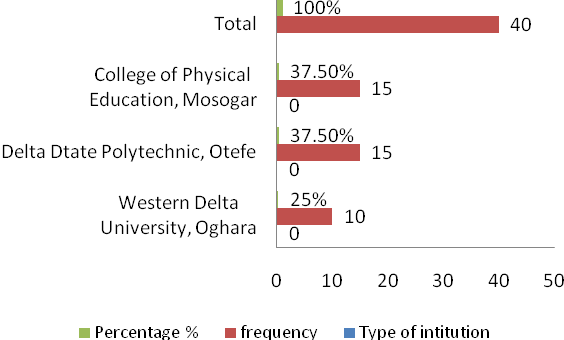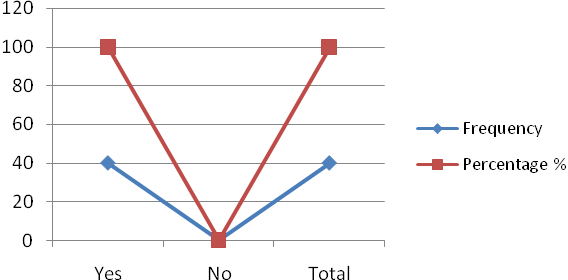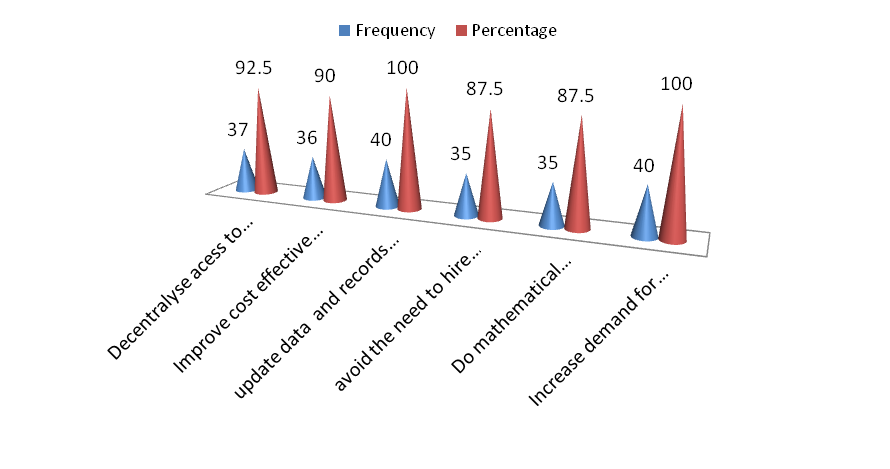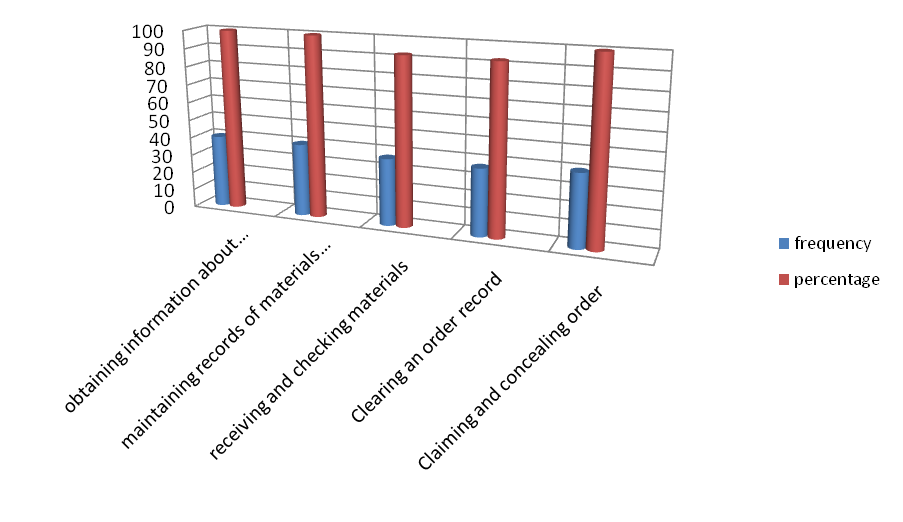-
Paper Information
- Previous Paper
- Paper Submission
-
Journal Information
- About This Journal
- Editorial Board
- Current Issue
- Archive
- Author Guidelines
- Contact Us
International Journal of Library Science
p-ISSN: 2168-488X e-ISSN: 2168-4901
2012; 1(4): 66-71
doi: 10.5923/j.library.20120104.04
Automation in Library's Collection Development and Acquisition Process in Academic Institutions in Delta Central, District of Delta State, Nigeria
Oghenovo Kelvin Onoriode 1, Oghenetega Ivwighreghweta 2
1ICT/Cataloging Librarian Western Delta University Library Oghara, Delta State, Nigeria
2Readers Service Librarian Western Delta University Library Oghara, Delta State, Nigeria
Correspondence to: Oghenovo Kelvin Onoriode , ICT/Cataloging Librarian Western Delta University Library Oghara, Delta State, Nigeria.
| Email: |  |
Copyright © 2012 Scientific & Academic Publishing. All Rights Reserved.
The study was carried was carried out to reveal the importance of automation to acquisition and collection development in academic libraries. The descriptive survey design utilizing questionnaire to collect data was employed. The data retrieved were analysed using frequency counts and simple percentage. It was revealed in the study that the libraries studied do not have automated library systems. That automation can therefore help in better management of the library collection and acquisition process and it is absolutely essential for a library to posses the resources that will enable it to meet its goals. However, automation is hampered by lack of fund, interest by administrators, poor electricity supplies etc. In Conclusion, Librarians must analyses their needs and plan the selection and implementation of automation system (Information and Communication Technology) that support the mission and priorities of the institution for acquisition and collection development that leads to effective library services.
Keywords: Automation, ICT, Collection Development, Acquisition, Academic Libraries
Cite this paper: Oghenovo Kelvin Onoriode , Oghenetega Ivwighreghweta , "Automation in Library's Collection Development and Acquisition Process in Academic Institutions in Delta Central, District of", International Journal of Library Science, Vol. 1 No. 4, 2012, pp. 66-71. doi: 10.5923/j.library.20120104.04.
Article Outline
1. Introduction
- The purpose of acquisition is traditionally to build local collections, and increasingly to control access to library materials. The role of acquisition is changing as a result of current developments in automation and electronic communication. The primary role of acquisition has traditionally been to serve the library rather than individual readers. As long as the library's collection is being built efficiently, the library as organisation becomes satisfied. But now, the relation of acquisition to access is in the process of redefinition; that is, incorporating the concept of acquisition as speedy access to information to individual reader[1]In addition,[2] use automated library to denote a library in which the collections of the Library materials are primarily on paper but in which the library's procedures have been computerised. Automation can therefore help in better management of the library collection and acquisition process. Also, the word automation has many connotations, but central to them is mechanical process. In the first place, it can be described as a technique by which mechanical processes are subjected to some degree of automation control without human intervention according to the new Webster’s Dictionary.However, automation, including the use of computers and other peripherals to do what has been done with the justification of reduced cost and better performance form the nucleus of this paper. Thus, automation as a process of redefining the routine task of managing the collection development and acquisition process in the library for better performance will be examined, tools and new technologies for automation shall be discussed and the benefit derivable will be looked at, in this paper.
2. Literature Review
- The history of library automation in according to[3] is not long when compared with libraries of developed countries. According to some scholars, university libraries started automating their services in the 80’s[4] and it is still at some stages. Commenting on the history of library automation in ,[5] stated that “ the first significant application of the computer to library function in was recorded in 1975, with the production of the first issue of the library computer catalogue of serials”. It is however argued that serious application of automation to library processes started in 1990’s as stressed further by[6] who stated that “serious application of automation to library processes started in Nigerian university libraries in the 1990’s. Individual efforts at library automation such as the one by the University of Lagos, University of Ibadan and Ahmadu Bello University, Zaria in the mid 1970’s and 80’s failed largely because of lack of technical know how relating to software development and maintenance of hardware” Also stressing the progressed recorded in library Automation in Nigeria,[7] lamented that; “library automation seems to have remained in pioneering stage for over two decades”.The new Webster's dictionary highlighted that, in the first place, automation can be described as a technique by which mechanical processes are subjected to some degree of automation control without human intervention.Furthermore,[1] wrote that automation has been a feature of acquisition department for many years, mainly in the form of automatic ordering systems. The advantages of automation are well known and include streamlined procedures and work flows, customized management and information system, sounder evaluation and stricter auditing. The inclusion of on order record in the library catalogue and direct loading of new titles announcement as potential order records gives library users enhanced access to available study materials. Accession list can easily be produced and selectors can easily be notified of new titles and approval as they appear, by using file transfer protocol, loading of approval and exchange data on local systems can be processed in minutes; Desiderata file can also be calculated, helping to fill the gap in the collection. According to[8], acquisition of books, reference materials, pamphlets, government publications, audio visual materials and database can be enhanced by automated library processes.[9] Wrote that, it is absolutely essential for a library to posses the resources that will enable it to meet its goals. That beautiful buildings, well trained staff and modern information storage and retrieval system can best be appreciated, if excellent services are given to users. This can be achieved faster with automated acquisition process.According to[10], once the new stock to be purchased for the library is selected, the automated system plays a prominent part. Although details will differ, there are three main steps - ordering, receiving and invoicing. The system then will allow the acquisition process to run, using its reporting system and order transmission. Also, the automated library acquisition system is equally powerful in aiding the acquisition process when it comes to financial control. That hen the total level of resources available for the library services as a whole is set, priorities for spending are then broken down across the various budgets heading e.g. fiction, periodicals, textbooks, databases etc. and budget holders are informed of their budget allocation and acquisition may proceed. Consequently, all the functions of acquisition processes and procedures can be done more efficiently in a relaxed mood and more cautiously in addition to speed and accuracy.Automating the acquisition processes in libraries will involve the use of ICT's to conceive, create, collect, cradle, communicate and consume information.[8] highlighted that automation comprises of hardware and software. Hardware is the physical data processing equipments, its peripherals and terminals. On the other hand, software is the collection of controlled programs used to make computers run and perform some specific functions. It includes items like operating systems, teleprocessing monitors, and utility programs that are written to process specific application or jobs for users. The combination of hardware and the software equipments to form computer can be used to carry out automated function such as;Arithmetic operations like addition, subtraction, multiplication and division, logically perform operations e.g book sorting and input operation like accepting data for processing and causing data to be printed[1] Stated that library users will demand a variety of information in diverse formats as Information resources now come in diverse electronic format. Materials currently acquired include CD"S, CD-ROM and other storage devices such as hard disk either plug and play or internally placed in the computer. Individual users are becoming used to locating materials on the internet thereby bye-passing the library and causing library management problems. Automation can then help acquisition librarian to acquire materials through networked technologies installed in the library. The internet can thus be used to acquire materials online through downloads of E-books and Journals, complete online edition of trade books and other academic publishing, suppliers own stock list giving prices and availability including online subscription to databases.[11], states that automation technology used in the libraries are; computers such as PC's (Personal Computers), desk top computers, laptop computers, PDA's (personal digital assistant), workstations, servers, mainframe computers etc. Peripherals which include fax machine, photocopier, LCD, keyboards, Cameras, bar code readers. Others include radio, telephone, Satellite Dish (V-Sat), Radio Mast and Towers.Furthermore, there are emerging technologies that are used in the automation of libraries and its acquisition process. These technologies are emerging because, the roles of libraries within and the services it offers to the community is changing rapidly with the rise of online services. Libraries who want to enhance user services and provide unmediated and independent access to library and its collections have began to work the ways of creating online communities. According to[11], these new technologies allow libraries to provide better services to users by offering simple access to what they want, when they want it and how they want it. Acquisition librarians can now make use of these emerging technologies to help build up the library resources and services. They are popular social networking sites, Such as; ● Facebook and twitter● Blogs - Web Logs● RSS - Rich Site Summary (an XML)● Wiki - Web page which can be viewed and modified by anybody with a web browser● Podcast - used for online delivery of videos● Web Conferencing● IM - Instant Messaging It is pertinent to automate the library acquisition process to ease collection development and acquisition of library resources. As a result of automated process available in the library, much of the work involves the accurate updating of records in files is made easier. Automation is likely to improve cost effective performance by increasing accuracy, reducing cost in labour intensive activities. Also, automation permits decentralized access to records. A librarian in a branch library can verify the status of an order without travelling to other department or asking other staff to interrupt their work in order to find out. A user can check to see if a book is out on loan without travelling to the library to see whether it is on the shelf[2].[12] Wrote that all libraries should be automated regardless of size (big or small) as they perform the same function of purchasing, cataloguing and loaning materials. Furthermore, libraries must maintain acquisition records and bibliographic data of any specific materials; they must also record multiple transactions to keep track of each patron and materials; know status by inputting all library data into one central database. In this vein, records maintenance is now both faster and more accurate. In addition, when libraries first began applying automation to their structures, It was not unusual to automate only one function such as acquisition or circulation, advances in library automation software now allows users of each function; whether staff or patron to access the same database. This means that update to this databases are seamless and accurate.On the part of[9], libraries may be automated for the following reasons;1. To enhance the library's reputation and can help the 2. library manager report on the various operations of the library.3. To help complete task more easily and accurately.4. To help do mathematical calculations5. Increased demand for services can be counter balanced with improved productivity especially with either static or declining budget resources.6. Automation can facilitate the collection of data which can assist the librarian in the management of library's collection. It can provide new and more detailed data in support of budget request.7. It can provide the means to offer new improved services to patrons and can facilitate cooperation between libraries8. Automation may eliminate staff position and the result may reduced staff cost for a particular activity.9. It may avoid the need to hire additional staff with increased demand for services.
3. Method
- The study employed a descriptive survey design utilizing questionnaire to collect data. A sample of 40 librarians in one University, one polytechnic and one of in Delta Central district of Delta State, which are , Oghara, Delta State Polytechnic, Otefe, Oghara and were used for the study.Copies of the questionnaire were administered to 40 librarians and all of the copies of the questionnaire were retrieved. The data retrieved from the questionnaire were analysed using frequency counts and simple percentage.
4. Research Question
- 1. To what extent are ICT facilities available in the Library?2. What is the role of automation in acquisition process?3. What are the acquisition functions that need to be automated?4. What the problems of automation in the library?
5. Findings and Discussion
- The findings and discussion are presented in Chart 1 – 6 as followsChart 1 above reveals that 15 (37.5%) of respondents are from , Mosogar. Also, 15 (37.5%) of respondents is from Delta State Polytechnic, Otefe, while 10 (25%) of respondents are from the , Oghara. The study reveals that there are more librarian in college of physical education, Mosogar and Delta State Polytechnic, Otefe.Chart 2 shows that 40 (100%) of respondents agreed that there is availability of computers in their library. This reveals that the management has bought computers for the library.Chart 3 shows that 37 (92.5%) agreed that automation can result in decentralized access to records, 36 (90%) says it can result in improved cost effective performance. While 40 (100%) are of the opinion that automation can result in update of data and records and increase in demand for services that can be counter balanced with improved productivity especially with static or declining budget and 35 (87.5%) agreed that it can help to do mathematical calculations. This study reveals that librarians in these institutions are aware of what automation could help them achieve.
 | Chart 1. Distribution of respondents among institutions |
 | Chart 2. Availability of Computer |
 | Chart 3. Automation of collection development process result in |
 | Chart 4. Automating collection development and acquisition process can help in |
 | Chart 5. what software do you use in your library |
 | Chart 6. what is the reason/problem why your library is not automated |
6. Conclusions and Recommendation
- The study revealed that , Oghara, Delta State Polytechnic, Otefe, and have computer system in their libraries. However, their libraries are not automated as pointed out in the study. The study also show that collection development and acquisition processes of obtaining information about materials, maintaining records of materials ordered as wells as claiming and concealing of orders can be done with automated systems. It was also shown that lack of management commitment, planning for automation as well as lack of electricity and technical skills impede automation of collection development and acquisition and the library in general.Librarians must analyse their automation needs and plan the selection and implementation of automation system (Information and communication Technology) that support the mission and priorities of the institution for efficient and improved services to the patron.
 Abstract
Abstract Reference
Reference Full-Text PDF
Full-Text PDF Full-Text HTML
Full-Text HTML